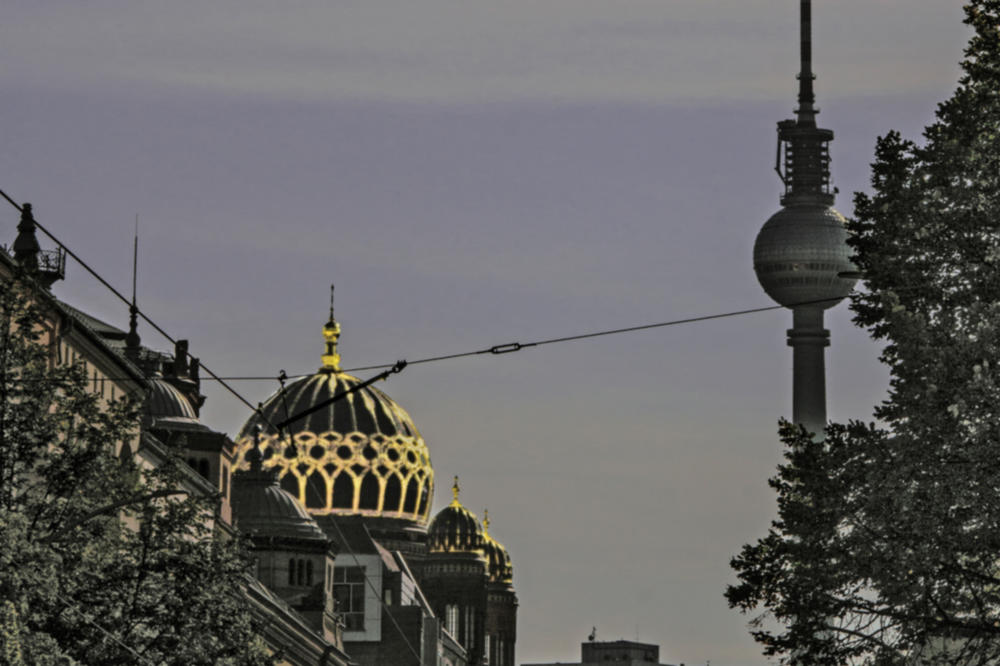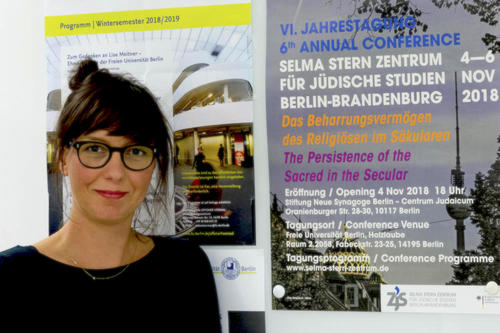“There Are Still Many Untold Stories.”
At the Selma Stern Center for Jewish Studies in Berlin-Brandenburg, scholars from five universities in Berlin and Brandenburg, a rabbinical college, and a research institute are conducting research.
Nov 27, 2018
The Selma Stern Center for Jewish Studies Berlin-Brandenburg is located in the historical center of Berlin.
Image Credit: René Koch/Berlin
Hans Söhnker was a successful actor during and after the Third Reich. He played in propaganda movies. But he also hid Jews persecuted by the National Socialists, saving their lives. In 2017, almost thirty years after his death, he was honored as “Righteous Among the Nations.” Yad Vashem, the Holocaust Memorial in Israel, presents this award to non-Jewish people who saved Jews from death during National Socialism at the risk of their own lives. The “Righteous Among the Nations as a Category of Remembrance” is also the subject of Manja Herrmann’s research. She is a postdoctoral researcher at the Selma Stern Center for Jewish Studies Berlin-Brandenburg.
The institution was founded in 2012 under the name Center for Jewish Studies Berlin-Brandenburg as a joint project of Freie Universität Berlin, Humboldt-Universität zu Berlin, Technische Universität Berlin, Universität Potsdam, and, since 2014, Europa-Universität Viadrina Frankfurt (Oder) as well as the Abraham Geiger Kolleg rabbinical college and the Moses Mendelssohn Center for European-Jewish Studies. In 2017, the Center was named after the historian Selma Stern (1890-1981), who was one of the first academically trained historians in Germany and the first woman in Jewish studies. In 1941, she fled with her husband Eugen Täubler — who at the time was the director of the Berlin Academy of Jewish Studies (Berliner Akademie für die Wissenschaft des Judentums), where she was also employed — from the National Socialists to the U.S. With her work “The Prussian State and the Jews,” Selma Stern laid the foundation for German-Jewish historiography.
The Selma Stern Center trains early-career researchers at the affiliated PostDoc Academy. Postdoctoral researchers work together with doctoral students in a total of four different research areas: They examine the relationship between the three monotheistic religions, the perspectives of the Sephardic Jews who emigrated from Spain in the 15th century, life in the Diaspora, and the culture of remembrance after the Shoah. As of this winter semester, Manja Herrmann has been leading the research area devoted to the culture of remembrance after the Shoah. She will continue to do so for the next three and a half years.
Manja Herrmann is a postdoctoral researcher at the Selma Stern Center and develops the concept of a research group on the remembrance category of the “Righteous Among the Nations” in the “Witnessing — memorial history (after) the Shoah” research fiel
Image Credit: Anne-Sophie Schmidt
“The number of the Righteous Among the Nations is not a statistical quantity.” Manja Herrmann
Yad Vashemhas honored over 26,000 people from over 50 countries since 1963. “In Germany, France, Poland, and Israel, their stories play an important role in the exploration, remembrance, and politicization of the Holocaust,” says Manja Herrmann. The number of “Righteous” persons is not a statistical quantity; however, it does have a specific function for the countries. Herrmann is interested in how the “Righteous” were perceived at different times in the almost 60-year history of reception. The fact that Hans Söhnker did not dare to speak publicly about his involvement until the 1960s, is a reflection of the way the Germans dealt with their past in the postwar years. “Manja Herrmann’s project has a very concrete connection with the history of the old Federal Republic,” says Rainer Kampling, deputy spokesperson for the Selma Stern Center and a professor of Biblical theology at Freie Universität Berlin. Kampling’s work focuses on Christian anti-Judaism and Jewish-Christian dialogue. “There are still many untold stories and unasked questions.”
Digging out and investigating these stories is one of the concerns of the Selma Stern Center. Jewish-Jewish encounters in the Mediterranean region, the so-called prohibition of images in monotheistic religions, and Jewish politics in modern times are also current focal points of research. The Selma Stern Center was needed, says Kampling. “There is no comparable research center in Germany that covers this diversity.” It also has an excellent infrastructure: researchers can use the libraries of the participating institutions as well as the numerous relevant archives and library holdings of the collaboration partners. The ZJS Judaica Portal was set up in cooperation with the Cooperative Library Network Berlin-Brandenburg, which helped to further strengthen the infrastructure.
“The Center is a permanent attempt not only to demand transdisciplinarity, but also to actively implement it,” says Rainer Kampling.
This diversity is due, in part, to the interdisciplinary nature of the research institute: all disciplines of the humanities are represented, from theology and Yiddish studies to law. “The Center is a permanent attempt not only to demand transdisciplinarity, but also to actively implement it,” says Kampling. The results are not only incorporated into the individual research projects. The Center’s annual meeting, conferences, workshops, and Leo Baeck Summer University — a two-week summer school for doctoral candidates in Jewish Studies — also benefit from the Center’s diversity of disciplines. The Selma Stern Center addresses the general public with its lecture series in the winter semester. An earlier series dealt with “The Forgotten Forgotten,” about Jewish poor people, maidservants, or cigar rollers. “We want to get away from the list of Jewish Nobel Prize winners,” says Rainer Kampling. “Jewish history is also a history of Jewish workers.”
This semester the focus is on migration. The program includes Jewish migration movements from ancient Greece, to migration to today’s Berlin. With these varied perspectives on such a current topic, the Selma Stern Center is being met with great interest; the lecture hall of the Center in Sophienstraße in Berlin-Mitte is regularly bursting at the seams, says Kampling.
Rainer Kampling is the deputy spokesperson for the Selma Stern Center and a professor of Biblical theology at Freie Universität Berlin.
Image Credit: Bernd Wannenmacher
As a collaborative project, the Selma Stern Center benefits from the unique characteristics of all participants: at Freie Universität Berlin, for example, there is the Institute for Jewish Studies, founded in 1963 as the first such institute in Germany in the postwar period; at Technische Universität, the Center for Research on Anti-Semitism; Jewish studies and Jewish theology can be studied at the University of Potsdam; at Abraham Geiger Kolleg, rabbi and cantor training takes place; aspects of cultural studies are taught and researched at Humboldt-Universität zu Berlin; literary aspects at Europa-Universität Viadrina Frankfurt (Oder) and; with the Hochschule für Musik Franz Liszt in Weimar, a more recent member, the Center also covers the history of Jewish music.
The Center’s diverse and outstanding research is what makes it so special, along with its friendly and cordial atmosphere.
The form of the collaboration enables the universities and institutes to work together in a spirit of trust. But it also means organizational effort. “From the outside, the collaboration appears almost miraculous,” says Kampling. Five universities, two federal states, and the federal government are financially involved. Therefore, there were coordination challenges in setting up the Center’s headquarters in Sophienstraße in Berlin-Mitte. Despite some initial hurdles, things are now going very well. The Center’s rooms have become an integral part of the research landscape and a communication space for a network that is now international. “Ever since it was founded, the Center has proved to be extremely successful and it continues to do so. Everyone involved is interested in good cooperation — you can see that.”
Manja Herrmann also values the Selma Stern Center for its internationality. “It’s easy to get in touch with outstanding international and national researchers.” The Scientific Advisory Board consists of renowned international researchers in the field of Jewish Studies; once a year they are available to postdoctoral researchers in advisory discussions.
A researcher from Israel and a colleague from Harvard University in the U.S. are currently sharing an office, according to Rainer Kampling. This is also what makes the Center so charming and special. The friendly and warm atmosphere of the Selma Stern Center is as popular as its diverse and outstanding research, says Kampling. “Researchers from all over the world hear about it and then want to see it for themselves.”



